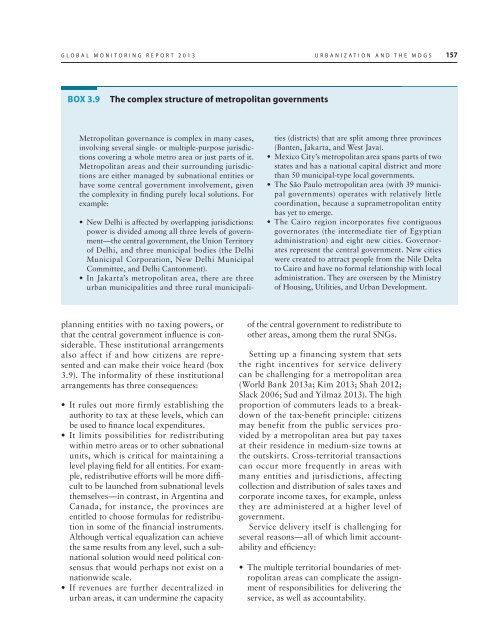rural-urban dynamics_report.pdf - Khazar University
rural-urban dynamics_report.pdf - Khazar University
rural-urban dynamics_report.pdf - Khazar University
You also want an ePaper? Increase the reach of your titles
YUMPU automatically turns print PDFs into web optimized ePapers that Google loves.
GLOBAL MONITORING REPORT 2013 URBANIZATION AND THE MDGS 157<br />
BOX 3.9<br />
The complex structure of metropolitan governments<br />
Metropolitan governance is complex in many cases,<br />
involving several single- or multiple-purpose jurisdictions<br />
covering a whole metro area or just parts of it.<br />
Metropolitan areas and their surrounding jurisdictions<br />
are either managed by subnational entities or<br />
have some central government involvement, given<br />
the complexity in finding purely local solutions. For<br />
example:<br />
• New Delhi is affected by overlapping jurisdictions:<br />
power is divided among all three levels of government—the<br />
central government, the Union Territory<br />
of Delhi, and three municipal bodies (the Delhi<br />
Municipal Corporation, New Delhi Municipal<br />
Committee, and Delhi Cantonment).<br />
• In Jakarta’s metropolitan area, there are three<br />
<strong>urban</strong> municipalities and three <strong>rural</strong> municipalities<br />
(districts) that are split among three provinces<br />
(Banten, Jakarta, and West Java).<br />
• Mexico City’s metropolitan area spans parts of two<br />
states and has a national capital district and more<br />
than 50 municipal-type local governments.<br />
• The São Paulo metropolitan area (with 39 municipal<br />
governments) operates with relatively little<br />
coordination, because a suprametropolitan entity<br />
has yet to emerge.<br />
• The Cairo region incorporates five contiguous<br />
governorates (the intermediate tier of Egyptian<br />
administration) and eight new cities. Governorates<br />
represent the central government. New cities<br />
were created to attract people from the Nile Delta<br />
to Cairo and have no formal relationship with local<br />
administration. They are overseen by the Ministry<br />
of Housing, Utilities, and Urban Development.<br />
planning entities with no taxing powers, or<br />
that the central government influence is considerable.<br />
These institutional arrangements<br />
also affect if and how citizens are represented<br />
and can make their voice heard (box<br />
3.9). The informality of these institutional<br />
arrangements has three consequences:<br />
• It rules out more firmly establishing the<br />
authority to tax at these levels, which can<br />
be used to finance local expenditures.<br />
• It limits possibilities for redistributing<br />
within metro areas or to other subnational<br />
units, which is critical for maintaining a<br />
level playing field for all entities. For example,<br />
redistributive efforts will be more difficult<br />
to be launched from subnational levels<br />
themselves—in contrast, in Argentina and<br />
Canada, for instance, the provinces are<br />
entitled to choose formulas for redistribution<br />
in some of the financial instruments.<br />
Although vertical equalization can achieve<br />
the same results from any level, such a subnational<br />
solution would need political consensus<br />
that would perhaps not exist on a<br />
nationwide scale.<br />
• If revenues are further decentralized in<br />
<strong>urban</strong> areas, it can undermine the capacity<br />
of the central government to redistribute to<br />
other areas, among them the <strong>rural</strong> SNGs.<br />
Setting up a financing system that sets<br />
the right incentives for service delivery<br />
can be challenging for a metropolitan area<br />
(World Bank 2013a; Kim 2013; Shah 2012;<br />
Slack 2006; Sud and Yilmaz 2013). The high<br />
proportion of commuters leads to a breakdown<br />
of the tax-benefit principle: citizens<br />
may benefit from the public services provided<br />
by a metropolitan area but pay taxes<br />
at their residence in medium-size towns at<br />
the outskirts. Cross-territorial transactions<br />
can occur more frequently in areas with<br />
many entities and jurisdictions, affecting<br />
collection and distribution of sales taxes and<br />
corporate income taxes, for example, unless<br />
they are administered at a higher level of<br />
government.<br />
Service delivery itself is challenging for<br />
several reasons—all of which limit accountability<br />
and efficiency:<br />
• The multiple territorial boundaries of metropolitan<br />
areas can complicate the assignment<br />
of responsibilities for delivering the<br />
service, as well as accountability.

















